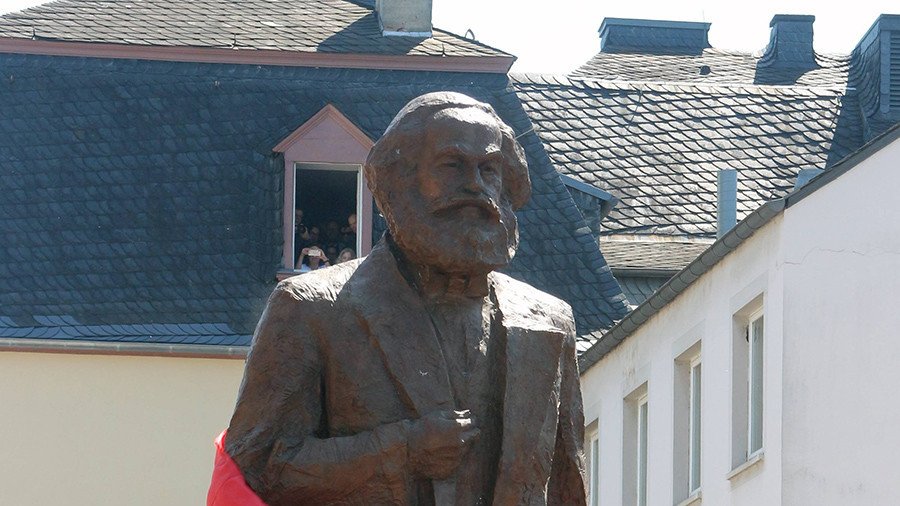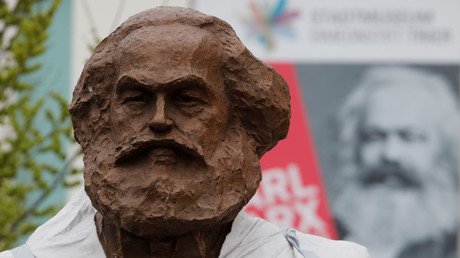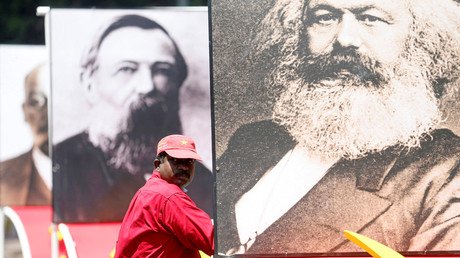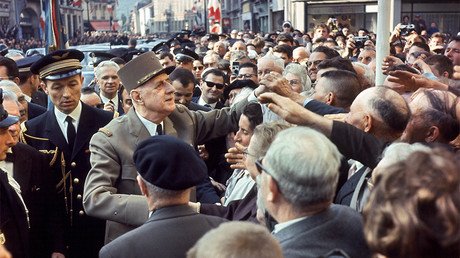Karl Marx sacrificed logic on the altar of his desire for revolution

Karl Marx, the committed revolutionary, once proved that the revolution need not happen. What did he do next?
Marx was a committed revolutionary, so much so that when reflecting on his life, he said that if he had it all to do over again, he would still be a revolutionary but would not marry, to save his wife from having to suffer the privations of life with him.
There were, of course, many committed revolutionaries in the 19th century. What set Marx apart from them all was that he had proven that revolution not only would happen, but had to happen. It was inevitable.
And then, one day, he proved, using a significant advance in his own economics, that revolution did not have to happen: that the inexorable force he had believed pushed in that direction was the outcome of a flaw in his own theory. When the flaw was corrected, the force was gone, and not only was revolution not inevitable, it might not even be necessary. How do you think he reacted?
He fudged, of course.
He distorted his logic to hide the result, while still continuing to use, in all other respects, the blinding new insight that both extended his logic, and revealed the fatal flaw in his earlier beliefs.
I can vividly imagine when he came to these revelations, because they are recorded live in his own handwriting. It happened one day in January 1858, as he wrote what became known as The Grundrisse: the ‘rough notes’ of his re-readings of the great economists as preparation for writing his magnum opus, Capital. By sheer chance, as he was reading Quesnay, Smith, Ricardo, Malthus, and many more, a friend dropped in with Marx’s own annotated copy of his philosopher master Hegel’s treatise Logic. Marx re-read it, and he started doing something he hadn’t done in 13 years: he began to think and write like a Hegelian philosopher.
The change in the language is dramatic, like reading the gonzo journalist Hunter S Thompson as he transits from one drug (say, cocaine) to another (marijuana) over a few paragraphs.
Until this point, the Grundrisse reprised the dry logic and prose of his adopted Ricardian methodology. Using this logic, years earlier, Marx had answered a question that Ricardo himself had never solved: if everything was bought at its value, and sold at its value, how did capitalists make a profit?
Following Smith and Ricardo, Marx argued that the use-value of a commodity played no role in setting its price. Instead, for these classical economists, price was determined by the cost of production.The intersecting demand and supply curves of Marshall were not for them. Decades earlier, they asserted that the long-term cost of producing an item determined the price for which it was sold.
Demand, in effect, set quantity only: price was determined by the cost of production. That in turn resolved itself to the amount of labour used to produce something. As Smith famously said:
If among a nation of hunters, for example, it usually costs twice the labour to kill a beaver which it does to kill a deer, one beaver should naturally exchange for or be worth two deer. It is natural that what is usually the produce of two days' or two hours' labour, should be worth double of what is usually the produce of one day's or one hour's labour.
Ricardo elaborated this slightly, noting that:
"Suppose the weapon necessary to kill the beaver, was constructed with much more labour than was necessary to kill the deer... one beaver would naturally be of more value than two deer."
But these were explanations of relative prices: they were not explanations of how those relative prices enabled capitalists to make a profit.
Smith and Ricardo simply assumed that they did: Marx proved that they did, by taking advantage of a unique characteristic of labour. For every other commodity, the buyer bought and got the commodity itself. But for labour, the capitalist buyer purchased labour-time: the capacity to work in a factory for, say 12 hours a day (a typical working day in Marx’s time). What he paid for this was the cost of production of the labourer him/herself: the means of subsistence. But these means of subsistence might only take, say, 6 hours of labour-time to produce. The gap between the amount paid to the worker (equivalent to six hours of labour) and the product enjoyed by its capitalist purchaser (12 hours of labour) was the source of the physical surplus of outputs over inputs generated in production, and this gap was unique to labour. In Marx’s words in 1847:
The labourer receives means of subsistence in exchange for his labour-power; the capitalist receives, in exchange for his means of subsistence, labour, the productive activity of the labourer, the creative force by which the worker not only replaces what he consumes, but also gives to the accumulated labour a greater value than it previously possessed.
With labour as the only source of surplus, and hence profit, Marx also hypothesized that competition between capitalists would lead to them mechanizing production more and more over time, leading to a higher ratio of machinery to labour (he called it the “organic composition of capital”) and therefore a lower rate of profit. Though he saw seven countervailing tendencies that might slow it down, this “Tendency for the Rate of Profit to Fall” was the inexorable force that Marx thought would lead, first to social conflict, then to the breakdown of capitalism, and finally to the rise of socialism. Whereas others before him had championed socialism as a preferable form of social organisation to capitalism, Marx believed he was the “Scientific Socialist” who had proven that socialism had to come about.
And then he re-read Hegel, re-acquainted himself with his dialectical philosophical roots, started writing in dialectical pairs, of foregrounds and backgrounds and unities, and found a far superior way to analyse capitalism.
This revolution in Marx's thought was misunderstood by most Marxists. Some ignored it completely, and described it as Marx “coquetting [flirting] with the Hegelian mode of expression.” This is rather like physicists rejecting Einstein because he “coquetted with the quantum mechanics mode of expression” to solve the problem of the photovoltaic effect.
Others confused Marx’s approach with the mumbo jumbo of “thesis, antithesis, synthesis.” This is not only virtually impossible to pronounce (you try saying it five times in a row without sounding like Daffy Duck), let alone apply, but also it belongs to Fichte, not to Hegel or Marx.
Marx’s dialectic is best abbreviated as “Society-Unity-Foreground-Background-Tension.” Everything exists in a given society, and is a unity in its own right. But society will focus upon one aspect of that unity, bringing it into the foreground. That necessarily pushes the other aspects of the unity into the background. Since the unity can’t exist without its background as well as its foreground aspects, that sets up a tension, which can transform the unity, and perhaps society itself, over time. It’s a philosophy of change, and ideally suited as a foundation approach to analyzing the economy, in contrast to the stale equilibrium foundations of modern neoclassical economics.
Marx’s first appreciation of this technique occurs in a two-page-long footnote, which starts with this opening sentence on page 267 of the Penguin edition of The Grundrisse:
“* Is not value to be conceived as the unity of use value and exchange value? In and for itself, is value as such the general form, in opposition to use value and exchange value as particular forms of it? Does this have significance in economics?”
This insight became the foundation of his economics from this point forward. He could now justify the Classical School argument that commodities exchange at their cost of production. The commodity was the key social unity in capitalism, and it had two aspects, use-value and exchange-value. Capitalism focuses upon exchange value, putting that in the foreground, and use value in the background. The former determines the price paid for a commodity, the latter is what motivates the exchange in the first place: a seller parts with the use-value of a commodity, which he doesn't need, to get its exchange-value, which he wants; the buyer pays its exchange-value and gets its use-value.
Marx’s immediate application of this insight was to develop a positive reason as to why labor was the source of profit: rather than relying on how labor differed from all other commodities, he now used what it had in common with them. Normally use-value is qualitative, and exchange-value is quantitative, and the two are incommensurable for that reason alone. But in production, the use-value that motivates the buyer to buy a commodity is quantitative: its capacity to produce other commodities for sale. With both use-value and exchange-value quantitative, there will be a difference between these two “intrinsically incommensurable magnitudes” (Capital I. Ch. 19) that is the source of surplus.
Marx's best statement of this in relation to labor was in Capital I itself:
“The daily cost of maintaining it [Labour], and its daily expenditure in work, are two totally different things. The former determines the exchange-value of the labour power, the latter is its use-value. The fact that half a [working] day’s labour is necessary to keep the labourer alive during 24 hours, does not in any way prevent him from working a whole day… The seller of labour power, like the seller of any other commodity, realises its exchange value, and parts with its use-value.”
He thus had a far more satisfying, positive proof as to why Labour was a source of surplus. But was it the only source? What about machinery as well?
In the Grundrisse, when he was still enthralled by his new methodology, he applied it correctly to machinery:
“It also has to be postulated (which was not done above) that the use-value of the machine [is] significantly greater than its value; i.e. that its devaluation in the service of production is not proportional to its increasing effect on production.”
But Gadzooks! This means that machinery can be a source of surplus as well. And if so, then an increasing “organic composition of capital” has no implications for the levels of surplus and profit: they could go up just as well as go down when production became less labour-intensive. The “Tendency for the Rate of Profit to Fall” disappears. Socialism is no longer inevitable.
Marx’s reaction to this shock discovery was to employ verbal gymnastics until such a time that he could fool himself that he had reconciled the two approaches (I’ll spare you the details, but you can check them out here, here or here). He then set about fooling everyone else, and finally declared emphatically—and falsely—that:
However useful a given kind of raw material, or a machine, or other means of production may be, though it may cost £150… yet it cannot, under any circumstances, add to the value of the product more than £150.
With this false statement swallowed by Marx’s followers, the belief in the inevitability of socialism continued. Accidents of history led to his Russia’s Bolshevik followers attempting to impose socialism on feudal Russia, and the rest is a very unfortunate history.
Marx also ruined his intellectual legacy with this subterfuge. His most fervent followers continue to champion the “Labour Theory of Value,” ignoring what Marx saw as his major advance over Smith and Ricardo. Though Marx’s many political and social critiques of capitalism continue to resonate today, his analytic contribution was to hobble his successors with defending an inane approach to economics that stymies their ability to analyse capitalism, rather than enhancing it.
So Marx’s legacies for his first 200 years are very poor indeed. His fallacious pre-Hegelian ideas led to a social experiment with hideous consequences that we are still, to some degree, living with today. His distortion of his own analytic method led his economic intellectual followers to waste their time trying to solve pointless conundrums in the equally pointless Labour Theory of Value.
It could have been otherwise. In his own PhD thesis on Hegel’s philosophy, Marx noted that a philosopher could undermine his own work, and that it was the duty of his followers to amend his error:
“It is conceivable that a philosopher should be guilty of this or that inconsistency because of this or that compromise; he may himself be conscious of it. But what he is not conscious of is that in the last analysis this apparent compromise is made possible by the deficiency of his principles or an inadequate grasp of them. So if a philosopher really has compromised it is the job of his followers to use the inner core of his thought to illuminate his own superficial expression of it.”
In the end, Marx was as human as Hegel: he sacrificed his own logic on the altar of his desire for revolution. Not only his family suffered for that devotion.
Think your friends would be interested? Share this story!
The statements, views and opinions expressed in this column are solely those of the author and do not necessarily represent those of RT.



















